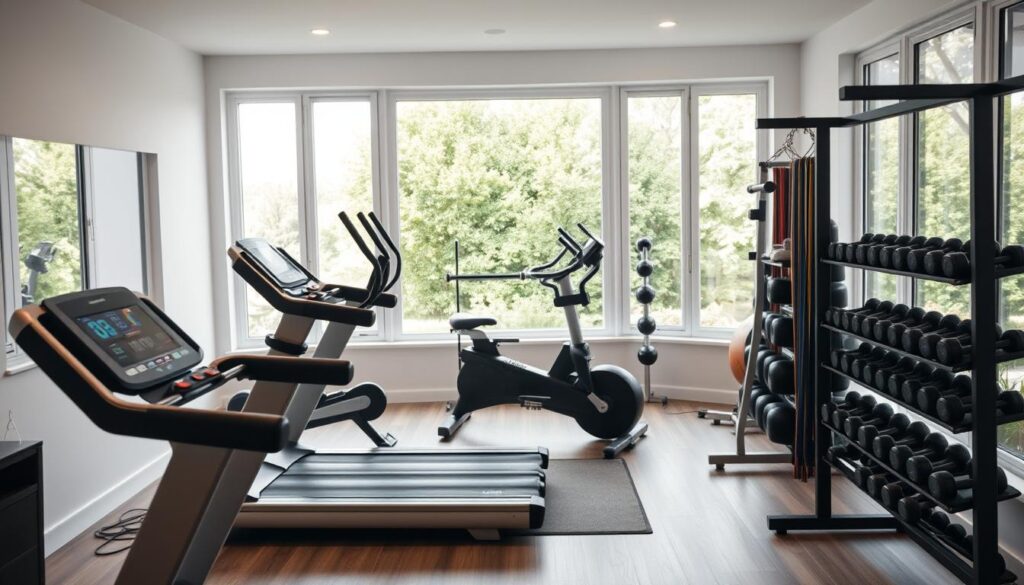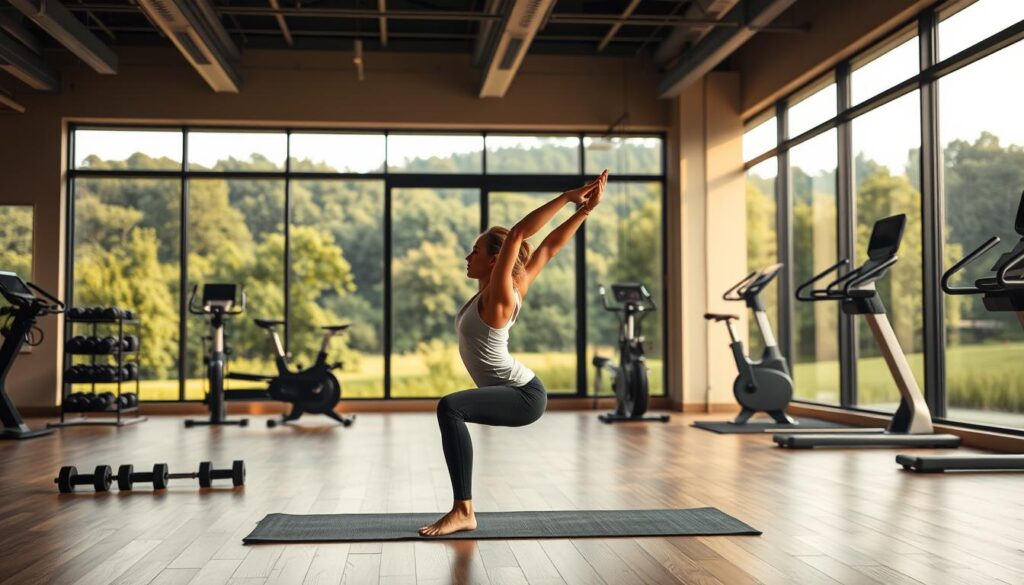Embarking on a fitness journey can be a daunting task, but with a well-structured exercise program, you can achieve sustainable results. Our comprehensive program is designed to address all aspects of fitness, including cardiovascular health, strength, flexibility, and balance.
This adaptable program is suitable for beginners and those looking to restart their fitness routine, and can be modified based on individual needs and goals, focusing on overall body wellness.
Key Takeaways
- A well-structured exercise program is crucial for achieving sustainable fitness results.
- Our program addresses all aspects of fitness, including cardiovascular health, strength, flexibility, and balance.
- The program is adaptable to different fitness levels and can be modified based on individual needs and goals.
- A comprehensive approach to fitness includes assessment, different types of exercises, nutrition support, and progression strategies.
- Starting a fitness journey doesn’t have to be intimidating with a step-by-step approach.
Understanding the Benefits of Regular Exercise
Regular physical activity is fundamental to enhancing both physical and mental health. By incorporating exercise into your daily routine, you can experience a wide range of benefits that improve your overall fitness and quality of life.
Immediate Benefits for Your Body and Mind
In the short term, exercise can significantly boost your mood, mental health, and sleep quality. It helps regulate hormones and blood pressure levels, leading to increased energy levels throughout the day. The cognitive benefits of exercise include improved concentration, reduced stress, and enhanced mental clarity.
- Improved mood through endorphin release
- Better sleep quality
- Increased energy levels
- Regulation of hormones and blood pressure
- Enhanced cognitive function
Long-Term Health Improvements
Consistent exercise contributes to maintaining a healthy body weight and muscle mass as we age. It reduces the risk of chronic diseases, such as cardiovascular disease, type 2 diabetes, and certain cancers. Regular physical activity also has a positive impact on heart health and bone density, which is particularly important as people get older.
By understanding the benefits of regular exercise, you can take the first step towards a healthier, more balanced lifestyle. Whether you’re looking to improve your physical health, mental well-being, or overall fitness, incorporating exercise into your daily routine is a crucial step towards achieving your goals.
Assessing Your Current Fitness Level
Evaluating your fitness level is the first step towards achieving your health and fitness goals. It involves assessing various components such as cardiovascular endurance, strength, flexibility, and balance. By understanding your current fitness level, you can create a personalized exercise program that suits your needs and minimizes the risk of injury.
Consulting a Healthcare Professional
Before starting any new exercise program, it’s essential for people to consult with a healthcare professional, especially if they have existing medical conditions, are over 40, or have a family history of heart disease. During the consultation, the doctor will ask about known medical disorders and symptoms, and perform a physical examination, including listening to the heart with a stethoscope. This evaluation aims to identify potential health risks that could lead to serious complications during exercise.
- Inform your doctor about any medical conditions or symptoms you’re experiencing.
- Discuss your family medical history, particularly any history of heart disease.
- Be prepared to undergo a physical examination.
Setting Realistic Fitness Goals
Setting SMART (Specific, Measurable, Achievable, Relevant, Time-bound) fitness goals is crucial for success. Your goals should be aligned with your personal motivations and adjusted according to your current fitness level and lifestyle factors. For example, a beginner might set a goal to walk for 30 minutes, three times a week, while a more experienced exerciser might aim to increase their running distance by a certain percentage within a specific timeframe.

By assessing your current fitness level and setting realistic goals, you can create an effective exercise program that improves your overall health and reduces the risk of injury. Regularly tracking your progress and adjusting your goals as needed will help you stay motivated and achieve your desired fitness level.
Types of Exercise for a Complete Fitness Program
A well-rounded fitness program should include a mix of different exercise types to achieve overall health and wellness. This variety ensures that you’re targeting different aspects of your physical health, from cardiovascular endurance to muscle strength and flexibility.
Aerobic Exercise for Cardiovascular Health
Aerobic exercises, such as walking, running, swimming, and cycling, are designed to improve heart health and increase endurance. These activities elevate your heart rate and breathing, enhancing cardiovascular health and burning calories. Regular aerobic exercise can also boost your mood and energy levels.
- Improves cardiovascular health
- Enhances endurance
- Burns calories
Strength Training for Muscle Development
Strength training involves exercises that focus on increasing muscle power, thickness, and strength. This can be achieved through resistance training and weightlifting. Strengthening your muscle mass not only enhances your physique but also increases your metabolism and supports joint health.
- Builds muscle mass
- Increases metabolism
- Supports joint health
Flexibility and Balance Exercises
Flexibility and balance exercises are crucial for preventing injuries, improving posture, and enhancing functional movement. Activities like yoga, Pilates, and simple stretching routines can significantly improve your flexibility and balance.
- Prevents injuries
- Improves posture
- Enhances functional movement
High-Intensity Interval Training (HIIT)
HIIT is an efficient workout method that combines cardio and strength benefits in shorter time periods. It involves short bursts of high-intensity exercise followed by brief periods of rest. Properly structuring a HIIT workout with work and rest intervals can maximize its effectiveness.
- Combines cardio and strength benefits
- Efficient use of time
- Improves overall fitness
Incorporating all four types of exercise into your weekly fitness program is essential for balanced development and overall health. By mixing aerobic exercise, strength training, flexibility and balance exercises, and HIIT, you can create a comprehensive routine that benefits your entire body.
Essential Equipment for Your Exercise Program
Starting a new exercise routine doesn’t have to mean splurging on fancy equipment. In fact, you can begin with little to no equipment at all. The key is to focus on exercises that utilize your body weight as resistance.
No-Equipment Options for Beginners
For those just starting out, there are numerous effective exercises that require no equipment whatsoever. Squats, lunges, pushups, and planks are excellent examples of body weight exercises that can be done anywhere. You can also get creative with household items; for instance, water bottles can serve as dumbbells, and a sturdy chair can be used for dips.
- Squats: Works your legs and glutes
- Lunges: Targets your legs and improves balance
- Pushups: Strengthens your upper body
- Planks: Enhances core strength and stability
Basic Equipment Worth Investing In
As you progress in your exercise program, you may find it beneficial to invest in some basic equipment. Resistance bands and dumbbells are versatile and affordable options that can add variety to your workouts. An exercise mat is also a worthwhile investment for comfort during floor exercises.
When selecting weights, it’s crucial to choose a weight that aligns with your current strength level. Proper care and storage of your equipment will ensure its longevity.

Creating Your Personalized Exercise Program
Designing a personalized exercise program is a crucial step in achieving your fitness goals. According to the Physical Activity Guidelines for Americans, a well-rounded exercise plan should include a mix of aerobic activity, resistance training, and flexibility exercises.
Determining Frequency and Duration
The Physical Activity Guidelines for Americans recommend at least 150 minutes of moderate-intensity aerobic activity or 75 minutes of vigorous-intensity aerobic activity per week. Additionally, incorporating resistance training exercises that target all major muscle groups at least twice a week is essential.
The duration of each exercise session can vary based on your fitness level and the type of exercise. For beginners, starting with shorter sessions and gradually increasing the time as fitness improves is a good strategy. For example, you might begin with 20-minute workouts and aim to increase the time to 30 or 45 minutes over time.
Balancing Different Types of Exercise
A balanced exercise program should include a mix of aerobic exercise, strength training, and flexibility exercises. The proportion of each type of exercise can vary depending on your specific fitness goals. For instance, if your goal is weight loss, you may want to prioritize aerobic exercise. On the other hand, if you’re focusing on muscle building, strength training should be your primary focus.
It’s also important to incorporate rest days into your routine to allow your muscles to recover. Active recovery techniques, such as light yoga or a leisurely walk, can help promote recovery on rest days.
“Consistency is key when it comes to seeing results from your exercise program. Stay committed, and you’ll be on your way to achieving your fitness goals.”
Week 1: Getting Started with Your Exercise Program
The first week of your exercise program is crucial for building habits and setting the tone for your fitness journey. This initial phase is designed to introduce you to a routine that is both manageable and enjoyable, ensuring you stay motivated to continue.
Day-by-Day Breakdown for Beginners
Here’s a detailed day-by-day breakdown of the first week of your exercise program, tailored specifically for beginners. This program is designed to be flexible, requiring no equipment, and can be adjusted according to your fitness level.
- Monday: Start with a 40-minute moderate-pace jog or brisk walk.
- Tuesday: Take a rest day to allow your muscles to recover.
- Wednesday: Begin with a 10-minute brisk walk, followed by a series of circuits. Rest for 1 minute after each set, and stretch afterward.
- Thursday: Another rest day to continue recovery.
- Friday: Engage in a 30-minute bike ride or moderate-pace jog.
- Saturday: Perform a strength training circuit.
- Sunday: Conclude the week with a 40-minute long walk.
This schedule balances workout days with rest days, preventing overtraining and allowing for recovery.
Proper Form and Technique Basics
Maintaining proper form during your workout is essential for preventing injuries and ensuring the effectiveness of the exercise. Focus on correct posture and alignment, and practice breathing techniques that complement your movements.
For common exercises like squats, lunges, pushups, and planks, pay attention to specific form cues:
- Squats: Keep your back straight and knees behind your toes.
- Lunges: Ensure your front knee is at a 90-degree angle and doesn’t extend past your toes.
- Pushups: Maintain a straight line from head to heels.
- Planks: Engage your core and keep your body in a straight line.
Mastering proper technique is crucial before increasing intensity or weight. Common form mistakes include arching your back during squats or letting your knees extend past your toes in lunges. Correct these by practicing slowly and focusing on your form.
Weeks 2-4: Building Consistency and Endurance
As you progress into weeks 2-4 of your exercise program, it’s essential to focus on building consistency and endurance. At this stage, you’ve already begun to adapt to the initial demands of your workout routine. Now, it’s time to gradually increase the intensity and duration to continue making progress.
Progressive Intensity Increases
To continue improving your fitness level, it’s crucial to apply the principle of progressive overload. This involves gradually increasing the demands on your body through added resistance, reduced rest periods, or increased repetitions. For instance, if you’re doing a workout that involves 3 sets of 10 repetitions, you could increase the intensity by adding another set or doing 12 repetitions instead of 10. The key is to make gradual increases that challenge your body without causing excessive strain.
Recognizing when you’re ready to progress to more challenging exercises or heavier weights is also vital. A good indicator is when you find that your current workout routine is becoming too easy. At this point, it’s time to either increase the weight, the number of repetitions, or decrease rest time between sets.
Tracking Your Progress
Tracking your progress is an essential part of any successful workout program. There are several methods to track your fitness progress, including using a workout journal, fitness apps, or wearable technology. Beyond tracking your weight, it’s beneficial to monitor other metrics such as resting heart rate, workout performance, energy levels, and sleep quality.
Celebrating small victories and non-scale wins is crucial for maintaining motivation. Whether it’s being able to do more repetitions or feeling more energetic throughout the day, acknowledging these achievements can help keep you motivated. Additionally, using a template to record your workouts and progress can help you identify plateaus and make necessary adjustments to your program.
Proper Nutrition to Support Your Exercise Program
A well-balanced diet is crucial for maximizing the benefits of your exercise program. Proper nutrition provides the body with the necessary fuel to perform at its best during a workout and aids in recovery afterward.

Pre-Workout Nutrition
Consuming the right nutrients before a workout is essential for optimizing energy levels and performance. Carbohydrates are particularly important as they help fuel muscles, especially during high-intensity exercise. It’s recommended to eat a meal or snack containing carbohydrates and protein 30 minutes to 3 hours before your workout.
Post-Workout Recovery Nutrition
After a workout, it’s crucial to replenish energy stores and support muscle recovery. Consuming a mix of protein and carbohydrates within 30-60 minutes after exercise can help repair muscle tissue and replenish glycogen stores. This “recovery window” is critical for maximizing the benefits of your workout.
Hydration Guidelines
Staying hydrated is vital for maintaining optimal performance during exercise. The Academy of Nutrition and Dietetics recommends that men consume 15.5 cups (3.7 liters) of water daily, while women should aim for 11.5 cups (2.7 liters). It’s also important to replenish fluids during and after exercise to prevent dehydration.
By focusing on proper nutrition and hydration, you can enhance your exercise performance, support your recovery, and achieve your fitness goals more effectively.
Warming Up and Cooling Down Properly
Warming up before exercise and cooling down afterwards are vital for preparing your body for physical activity and aiding in recovery. A proper warm-up routine increases your heart rate and blood flow to the muscle groups you’ll be using, making your exercises more effective and reducing the risk of injury.
Dynamic Warm-Up Exercises
Dynamic warm-up exercises are designed to prepare your body for movement. Examples include leg swings, arm circles, and torso twists. These exercises help increase flexibility and range of motion, making them an essential part of your warm-up routine.
To tailor your warm-up to your specific workout, focus on the muscle groups you’ll be using. For example, if you’re going for a run, do some light jogging in place or jumping jacks to get your legs ready.
Effective Cool-Down Stretches
Cooling down after your workout is just as important as warming up. Effective cool-down stretches help reduce muscle soreness and improve recovery by gradually bringing your heart rate back to normal. Focus on static stretches that target major muscle groups, such as hamstring, quadriceps, and chest stretches.
When performing static stretches, hold each stretch for 15-30 seconds and breathe deeply to help your body relax. This will not only aid in physical recovery but also provide a psychological transition from exercise to rest.
Avoiding Common Exercise Injuries
To maintain a consistent exercise program, it’s essential to know how to minimize the risk of injury. Understanding the causes of common injuries and how to prevent them can help you stay on track with your fitness goals.
Understanding Your Body’s Signals
It’s crucial to differentiate between productive muscle fatigue and warning signs of potential injury. If you experience pain or discomfort during a workout, stop and rest before continuing. Pushing through pain can lead to more severe injuries. Recognizing the various types of pain and knowing when to stop exercising is vital for preventing harm to your body.
Modifying exercises when experiencing discomfort, rather than abandoning workouts completely, can also help in avoiding injuries. This approach allows you to continue your fitness journey while minimizing the risk of exacerbating the discomfort.
Proper Recovery Between Workouts
Allowing for adequate recovery time between workouts is essential for muscle repair and growth. Muscles need about 48 hours to recover after being exercised heavily. During this period, microscopic tears in muscle fibers are repaired, and the muscles are strengthened.
Active recovery strategies, such as light cardio or stretching, can promote healing while maintaining movement. Additionally, sleep plays a significant role in exercise recovery and muscle development, as it allows your body to repair and adapt to the demands placed upon it.

Determining appropriate rest periods based on workout intensity and individual factors is also crucial. It’s essential to know when to seek medical attention for exercise-related pain or injuries that do not improve with rest.
- Identify the most common exercise-related injuries and their primary causes.
- Understand the importance of the 48-hour recovery period for exercised muscle groups.
- Implement active recovery strategies to promote healing.
Adapting Your Exercise Program for Special Conditions
Adapting your exercise program to suit your needs is crucial for a safe and effective fitness journey. Different people have varying physical conditions and limitations that require personalized approaches to exercise.
Exercise Modifications for Beginners
For those new to exercise, modifications are essential to prevent injury and build confidence. Beginners can start with simpler versions of exercises, such as wall pushups instead of floor pushups, or chair squats instead of full squats. As strength and mobility improve, they can gradually progress to more challenging exercises.
Adjustments for Older Adults
People in their older age may need to adjust their exercise program to accommodate age-related concerns such as arthritis or osteoporosis. Exercises that focus on balance, fall prevention, and joint-friendly movements are particularly beneficial. For example, water-based exercises or tai chi can be excellent options.
Working Around Minor Injuries
When dealing with minor injury, it’s possible to continue exercising by focusing on unaffected body parts. This concept, known as “training around an injury,” allows individuals to maintain their fitness level while allowing the injured area to heal. For instance, if someone has knee pain, they can still perform upper body exercises or non-weight-bearing lower body exercises.
Making modifications to your exercise routine is not only about addressing limitations but also about ensuring long-term sustainability and enjoyment of your exercise program. Always consult with healthcare providers for personalized advice, especially when exercising with medical conditions.
Staying Motivated with Your Exercise Program

One of the biggest challenges people face when starting an exercise program is staying motivated. It’s easy to begin with enthusiasm, but maintaining that motivation over time can be difficult. An important factor in staying motivated and continuing to exercise long term is having fun while doing it.
Setting Achievable Milestones
Setting progressive, achievable goals is crucial for maintaining motivation. By achieving regular milestones, you can experience a sense of accomplishment that propels you forward. Examples of milestones include completing a 5K run, doing 10 pushups in a row, or exercising consistently for a month. Celebrating these milestones in healthy, meaningful ways can further enhance your motivation.
Finding Workout Partners
Exercising with a friend or in a group can significantly boost your motivation. It not only adds a social element to your workout routine but also helps maintain accountability. You can find compatible workout partners by joining fitness communities or participating in group fitness activities, both in-person and virtually.
Using Technology to Track Progress
Technology can greatly enhance your exercise experience through tracking, gamification, and community support. Popular fitness apps and wearable devices can help you monitor your progress, set appropriate goals, and stay motivated. By leveraging data from tracking technology, you can recognize your achievements and adjust your program as needed to stay on track.
Maintaining intrinsic motivation, or exercising for how it makes you feel, is more sustainable than extrinsic motivation, which is driven by appearance. By focusing on the positive feelings associated with regular workout and incorporating a variety of exercises into your routine, you can keep your exercise program enjoyable and motivating.
Advanced Progression: Taking Your Exercise Program to the Next Level
Once you’ve established a solid foundation in your exercise program, you can start thinking about taking it to the next level. This involves understanding when and how to increase intensity and incorporating more advanced training methodologies.
When and How to Increase Intensity
To continue making progress, it’s crucial to recognize when to boost your workout intensity. This can be determined by monitoring your performance plateaus and recovery capacity. For aerobic exercise to be effective, your heart rate should be within 60 to 85% of your maximum rate. Interval training, such as HIIT, alternates between moderate and intense exertion, enhancing cardiovascular benefits.
Methods for increasing workout intensity include adding weight, increasing repetitions, reducing rest periods, and boosting workout frequency. Maintaining proper form is essential even as you challenge yourself. Calculating and using target heart rate zones can optimize your cardiovascular training.
Incorporating Specialized Training Methods
Advanced training methodologies include periodization, supersets, drop sets, and pyramid training. You can also incorporate specialized approaches like plyometrics, Olympic lifting, or sport-specific training. Cross-training can improve overall fitness while preventing overuse injuries. Consider working with a personal trainer or coach to safely advance to more complex methods.
As you increase training intensity, your recovery needs will change. Adjust your recovery strategies accordingly to avoid overtraining. Signs of overtraining include persistent fatigue and decreased performance. Balance challenging yourself with adequate recovery to ensure continued progress in your exercise program.
Conclusion
A successful fitness journey is built on a foundation of consistency, patience, and a well-structured exercise program. As we’ve explored throughout this article, a comprehensive approach includes a balance of aerobic exercise, strength training, flexibility work, and proper recovery. This balanced approach is crucial for achieving your goals and improving overall health.
It’s essential to remember that consistency is more important than perfection when starting a fitness journey. The program outlined is designed to be adaptable, evolving as your fitness level improves. Be patient with yourself and recognize that sustainable fitness is a marathon, not a sprint. Regular exercise offers multifaceted benefits beyond physical appearance, including improved mood, energy, sleep, and overall health.
Everyone’s journey will look different based on individual goals, preferences, and starting points. It’s normal to encounter setbacks, but they are part of the process. We encourage you to start implementing the program immediately, even if you begin with just one component. The most important step is simply getting started, and every workout brings you closer to your goals. By taking control of your health and wellbeing through regular exercise, you’re investing in a healthier, happier you.
As you embark on this fitness path, remember that it’s about progress, not perfection. With a well-rounded exercise program, you’re on the path to achieving a healthier body and a stronger heart. Start your week with a positive step towards your fitness goals, and stay committed to your journey.
